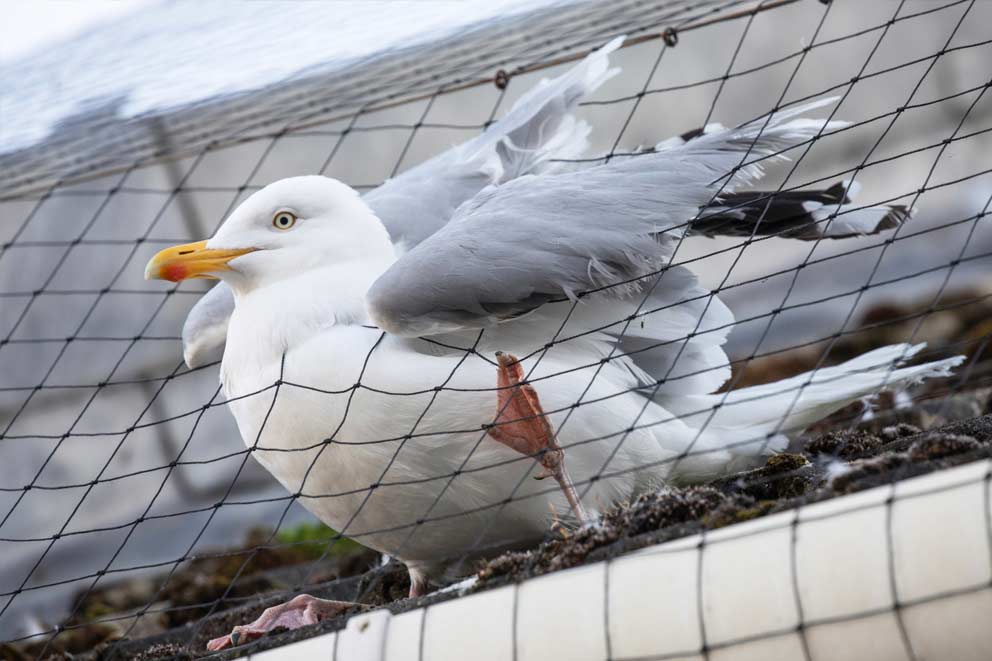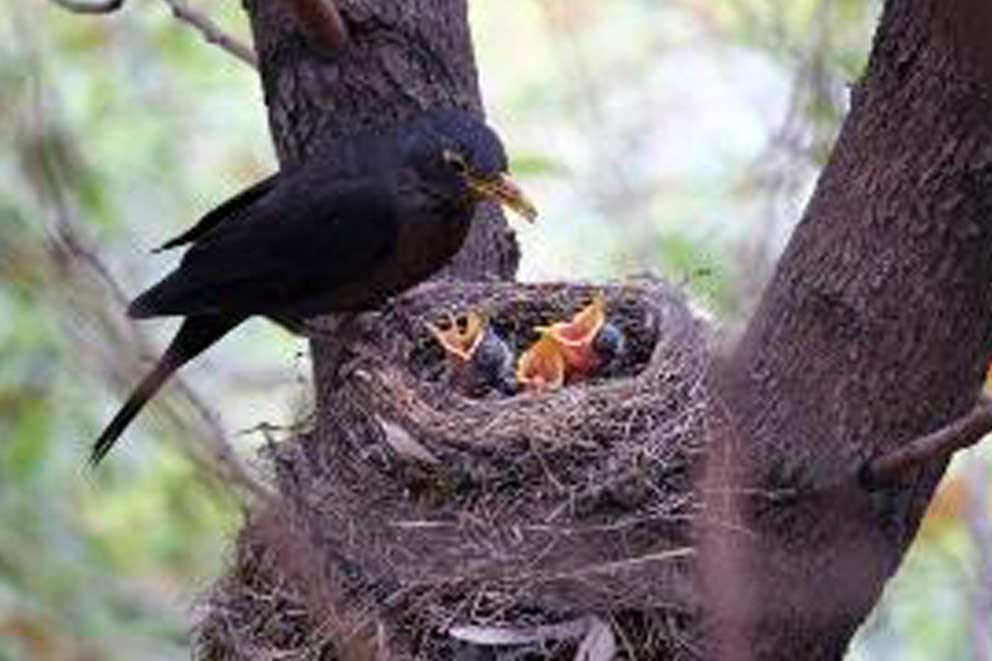Trapped birds
If you find a wild bird trapped in an awkward place such as in a chimney or under netting, here's what you can do to help.

Bird flu warning
Due to the Avian Influenza Prevention Zone (AIPZ) currently in place across the UK, some baby birds can't be handled. Please follow our bird flu and baby bird advice to check which species can be handled and what to do.
Found a bird trapped in a difficult place
A bird could get trapped:
- Under floorboards
- Behind bricked-up fireplace
- In a cavity wall
- Chimney
If you find a trapped bird in an inaccessible place (e.g. under floorboards, behind a bricked-up fireplace, in a cavity wall or chimney) please contact an appropriate professional such as a builder.
RSPCA inspectors are not trained or equipped to handle these types of incidents.
Bird trapped in an unoccupied building
If the building is for sale/to let, make a note of the agent's contact details if known. Pass on anything that you can find out to us.
Bird trapped on ice
In 99.9% of reported occurrences, the bird is not actually stuck, despite appearing to be so. Never attempt to rescue a bird that appears to be stuck on ice. Instead, safely monitor the animal for three hours.
If the bird has not moved after three hours (including prior to calling our RSPCA helpline) - let us know and we will take further action.
Found a bird trapped in netting
Follow these steps depending on the circumstance you find the bird:
- For building netting, contact the owners of the building or construction site where the netting is situated as they're legally responsible for maintaining the netting.
- For hedge/tree/cliff netting - the issue is usually caused by hedges being netted in advance of construction work. In this case, please contact the construction company/developers where the netting is situated as they are also legally responsible for maintaining the netting.
- If you've seen birds becoming trapped in the same netting on several occasions, or multiple dead birds trapped in netting, and nothing has been done by the people responsible for the netting, please contact us as this may be an offence.
Can I cut or remove the netting myself?
Unfortunately, the use of such netting is currently legal. We advise that you or any other member of the public don't damage, cut or remove any netting as this could leave you or them liable to a charge of criminal damage. Additionally, damaged netting could risk trapping more animals under it.
Netting is often used in this way by property developers to prevent birds from nesting in trees/hedges that workers are planning to remove for development work.
We don't agree with the use of netting in this way and recommend that any development work requiring the removal of such nesting sites should wait until after the nesting season (if it's required at all).
What to do with a bird trapped in a chimney
Some birds will choose a chimney as an alternative nesting site to one in a tree. Any birds seen nesting in a chimney should be left alone. Wild birds, their eggs and young are protected by law.
Remember that some birds will have multiple broods in the same year, so the nest may still be in use even if you've seen birds leaving it recently.
If the owner of the property doesn't want the birds to return to the chimney to nest the following year, a professional can be called in to prevent the birds from getting back in.
The usual method is to attach a wire mesh guard or cowl to the top of the chimney after the nest has been abandoned, in order to deter the birds from nesting in that location in the future.
Any fully feathered adult bird that's trapped can be removed and released during the day if they're not injured and appear lively, alert and showing no signs of being affected by soot.
Don't remove the bird if they
- Appear dazed (which is quite likely)
- Have been trapped in the chimney for a number of hours
- Appear to be injured (for example, they have a damaged wing or soot in their eyes)
- Seem to be young (a partly feathered nestling or fledgling that is found in the spring or summer).
If the bird is showing any signs of the above, then the quickest way to get them help will be to contact a vet.
Birds that have come down a chimney and are flying in the room will navigate to the nearest, brightest light source. For this reason, it's advisable to provide only one exit point to avoid confusing the bird. Leave an external door or a single window open, turning the lights off, and draw the curtains over closed windows. You can try placing a torch at the bottom of the chimney (so that the floor is visible, don't point it straight up the chimney at the bird).
If you discover a bird trapped in a chimney, you can help by opening all the windows and any external doors in the room. Pull any curtains all the way back and then leave the room and monitor the situation for two hours. If a bird is injured but still flying, never try to catch it by throwing a towel or blanket over it as this can make their injuries worse.
If the bird appears to be sick or injured once free from the chimney, please read our advice on what to do.
Found a bird inside a property
- Give the bird time to find their own way out
- Open an external door or window and give only one source of light (block off all other light sources, including the fireplace)
- It may take some time for the bird to leave, so the room should be left quiet and empty
- Follow by monitoring quietly for two hours
- If all options fail - pass on all available information to our animal rescuer
Found a bird trapped behind or above a gas fire
Only British Gas Service Engineers or Gas Safe Register engineers are permitted and qualified to disconnect/reconnect gas mains or appliances. You will need to contact one of the above to have a fire disconnected before any attempt can be made to rescue the animal. They will charge for the service with costs varying throughout the country.
Unfortunately, due to limited resources, we're not able to pay for or make a contribution to the disconnection/reconnection of a gas-fire appliance.
All costs of disconnections or re-connections are the responsibility of the tenant, homeowner or pet owner.
Pensioners may wish to approach Age UK (formerly Age Concern) for assistance. While anyone on benefits should appeal to British Gas Services or make a direct complaint via the Gas Consumers Council.
If you find a bird in a gas appliance, our animal rescuers are not able to remove the bird themselves. Even if the bird is trapped in or behind a disconnected appliance, a gas-safe registered engineer still needs to move the appliance due to health and safety issues.
Our RSPCA animal rescuers can't help remove birds or other animals trapped behind gas appliances because our team is not qualified to work on any gas fittings.
Do I have to disconnect my gas appliance to help a trapped bird?
We understand that you may not want to have your gas disconnected professionally and while there is no legal obligation for a member of the public to disconnect a gas fire to get a bird out - please do be aware that there may be health and safety issues that a rotting carcass can pose to humans. For all concerned, it would be better to do what is needed to release the trapped bird.
Once the gas supply has been disconnected, open external doors and windows, pulling any curtains out of the way. Place a torch in the chimney, shining on the floor to help coax the bird towards the light. Leave the room quiet and empty. This may take some time, so leave the room undisturbed for a few hours.
Once the bird has been freed, if uninjured and strong enough to fly, it should be allowed to escape through an open door or window. Alternatively, it may be confined and then released safely outside. If the bird is injured or too weak to fly, please read our advice on caring for injured wildlife.
Video: How to help a bird
A bird has flown into a window
For advice on what to do if a bird has flown into a window.



